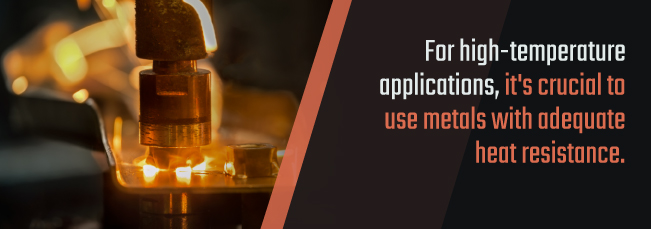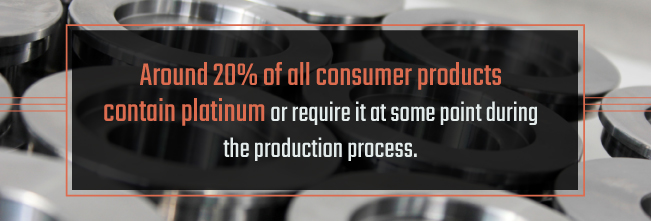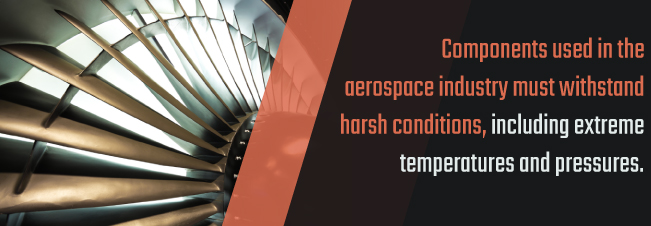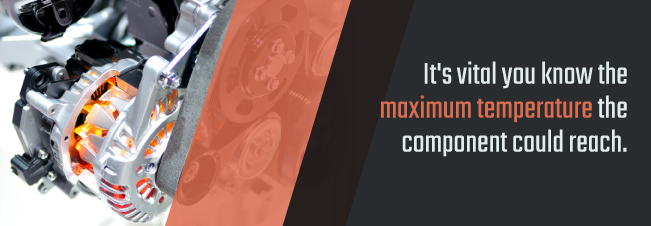Plating your components, a process that applies a thin metal coating to the outside of a substrate, provides many benefits. It can improve various characteristics, such as hardness or corrosion resistance, to a part or even introduce new ones, like electrical conductivity or magnetism. One sought-after feature plating can enhance is resistance to high temperatures.
In many applications, exposure to high temperatures is unavoidable. These situations require an understanding of what temperatures a component will be exposed to so you can choose plating and base materials that can withstand these conditions.
At Sharretts Plating Company, we can help you choose the right materials for your project and offer the plating and other finishing services you need. Below, you will find more information about plating for high-temperature applications.
How Metals React to High Temperatures
Different metals react to high temperatures in different ways. Other conditions, such as pressure, can impact a material’s reaction to heat as well. If you do not use elements with enough heat resistance, or do not take the proper precautions, you might encounter unwanted impacts to your product. In extreme cases, damage from heat can even lead to failure.
Rising temperatures can cause metals to expand. When temperatures fall, the metals contract. Although this change is not drastic, it can have severe impacts. For example, a high-temperature alloy might expand by a quarter of an inch for each foot of material when the temperature goes from ambient to 1,000 degrees Celsius, or 1,832 degrees Fahrenheit. This expansion and contraction can cause cracking and distortion in the material.
Repeated changes in temperature can cause a fatigue failure mechanism called thermal fatigue, which causes cracks that may spread and lead to failure if not remedied. The more extreme and frequent the temperature fluctuations, the more likely thermal fatigue is to occur.
Another challenge when using metals in high-temperature environments is corrosion. High-temperature corrosion does not require a liquid electrolyte. Instead, the metals react with atoms in the atmosphere surrounding them. This reaction can occur at temperatures above approximately 1,200 degrees Fahrenheit.
Various types of high-temperature corrosion can affect metals including:
- Oxidation, which involves the presence of oxides
- Sulfidation, which involves the presence of sulfides
- Halogenation, which involves the presence of halogens
- Carburization, which involves the presence of carbides
- Nitridation, which involves the presence of nitrides
Some materials offer improved resistance to corrosion, and plating components with these materials can help prevent damage caused by corrosion. Many alloys develop a protective scale caused by oxidation that can prevent further high-temperature corrosion.
Metals That Can Withstand High Temperatures
For high-temperature applications, it’s crucial to use metals with adequate heat resistance. Metals have different melting points, which indicates the highest temperature they can withstand.
Heat resistance is not the only factor to consider, though, even in high-temperature environments. Wear resistance, corrosion resistance and other considerations are also vital. For this reason, manufacturers often use alloys that combine multiple metals and other elements to get the characteristics they require. High-temperature alloys often have a base of iron, nickel or cobalt. They also typically contain 20 to 30 percent chromium as well as other elements such as aluminum, silicon and refractory metals, a group of metals characterized by their high melting points.
Refractory metals are the most heat-resistant of any metal, but they also oxidize at relatively low temperatures. Because of these, you need to apply a protective coating to them before using them in high-temperature environments.
Industrial refractory metals include:
- Tungsten, which has a melting point of 6,170 degrees Fahrenheit
- Rhenium, which has a melting point of 5,756 degrees Fahrenheit
- Tantalum, which has a melting point of 5,425 degrees Fahrenheit
- Molybdenum, which has a melting point of 4,742 degrees Fahrenheit
- Niobium, which has a melting point of 4,474 degrees Fahrenheit
Many components never see temperatures as hot as the most extreme that refractory metals can withstand. Many industries consider temperatures above 300 degrees Fahrenheit high.
Metals that can withstand high temperatures include:
- Ruthenium, which has a melting point of 4,082 degrees Fahrenheit
- Rhodium, which has a melting point of 3,571 degrees Fahrenheit
- Platinum, which has a melting point of 3,222 degrees Fahrenheit
- Titanium, which has a melting point of 3,020 degrees Fahrenheit
- Palladium, which has a melting point of 2,826 degrees Fahrenheit
- Stainless steel, which has a melting point of 2,750 degrees Fahrenheit
- Nickel, which has a melting point of 2,647 degrees Fahrenheit
- Copper, which has a melting point of 1,981 degrees Fahrenheit
- Gold, which has a melting point of 1,947 degrees Fahrenheit
- Silver, which has a melting point of 1,764 degrees Fahrenheit
- Aluminum, which has a melting point of 1,220 degrees Fahrenheit
- Magnesium, which has a melting point of 1,182 degrees Fahrenheit
- Zinc, which has a melting point of 787 degrees Fahrenheit
- Tin, which has a melting point of 494 degrees Fahrenheit
Often, manufacturers will combine the metals on this list or add other materials to them to increase their heat resistance or other characteristics, especially when using plating.
Types of Plating for High Temperatures
Various types of plating see use in high-temperature environments. The one that’s right for your component depends on the conditions it will have exposure to. Here are some plating types that are ideal for high temperatures. In addition to pure metals, metal finishing often involves the use of alloys to obtain the characteristics needed.
- Ruthenium is a rare transition metal that’s part of the platinum group of metals. Despite its rarity, though, it is cost-effective. It’s highly heat-resistant, strong and durable, as well as chemically inert, which means it will not react with chemicals. It also acts as a catalyst for splitting hydrogen sulfide compounds. Because some ruthenium compounds can absorb light, you can find it in solar power technologies. It’s also common in electronics and data storage.
- Rhodium is one of the rarest metals that comes from the Earth’s crust. Like ruthenium, it’s also one of the six platinum-group metals, which means it is chemically inert. It’s known for its extreme durability, excellent corrosion resistance, high density and high melting point. Manufacturers often alloy rhodium with palladium or platinum.
- Platinum is a precious metal that has a high melting point and resists corrosion even at high temperatures. It is one of the least reactive metals and has exceptional wear resistance. Because it absorbs excess hydrogen, the auto industry often uses it. Its biocompatibility makes it useful in the medical field. Around 20 percent of all consumer products contain platinum or require it at some point during the production process.
- Palladium shares some characteristics with many precious and refractory metals, but it is less dense than platinum-group metals. It is valued for its corrosion resistance, solderability and wear resistance. Like platinum, it can also absorb hydrogen. This cost-effective metal is typical in consumer electronics. Palladium nickel reduces susceptibility to cracking as compared to pure palladium. Our palladium nickel alloy is approximately 80 percent palladium and 20 percent nickel. It has excellent corrosion resistance, low porosity and high heat resistance due to its high density. It often sees use in the electronics industry. Palladium is also alloyed with cobalt to a similar effect.
- Nickel and electroless nickel plating offer excellent corrosion resistance, wear resistance, hardness and resistance to the elements. Electroplated nickel has a higher melting point and less deposit stress, while electroless nickel plating has superior resistance to corrosion and wear. SPC offers sulfamate and sulfate nickel electroplating. Nickel coatings are sometimes alloyed with tungsten, tin, boron and manganese to improve resistance to corrosion, hardness and conductivity further. The automotive, aerospace, communication and textile industries often use nickel plating.
- Copper has outstanding thermal and electrical properties and also offers protection from corrosion. It’s also highly malleable, so it doesn’t break if bent. These characteristics make it useful in the electrical, heating and industrial sectors. Copper allows for selective heat-treating, which enables it to function as a heat treat stop-off for masking. Copper is highly active, which impacts how you can use it.
- Gold can protect substrates from heat, corrosion and wear. It also makes an excellent conductor. It plays a vital role in the production of electrical components and also frequently sees use in the aerospace and medical fields. While gold is expensive upfront, it is incredibly effective and could result in cost reduction over the long term.
- Silver, a noble metal, provides outstanding thermal and electrical conductivity, as well as low-contact resistance and protection from corrosion. It can also withstand chemicals and acids well. The telecommunications industry uses silver heavily because of these characteristics, as do the auto, electronics and solar energy industries. It’s also valuable in the medical field due to its antimicrobial properties. You can alloy silver with more metals reasonably easily.
- Zinc resists corrosion exceptionally well, and this corrosion protection can be enhanced by alloying it with other metals such as nickel, cobalt and iron. Compared to zinc plating, zinc nickel plating has 10 times greater corrosion resistance. Zinc nickel alloys are typically 6 to 20 percent nickel and 80 to 94 percent zinc. The high temperature limit of zinc plating provides another advantage. It is often used to plate nuts, bolts and other small components and can act as an undercoating on a surface before painting. The automotive and defense industries also use it frequently.
High-Temperature Plating Applications
High temperatures are a necessary part of operations across many industries. Ensuring components can withstand any extreme heat they may encounter is crucial to the success of businesses, the safety of personnel and the daily lives of consumers. At SPC, we have experience working with a variety of sectors and understand what a diverse set of businesses needs to succeed. Below are some of the industries we work with that require plating for high-temperature applications.
Automotive
The metals used in automobile engines need to withstand high temperatures as well as corrosion. To this end, automotive companies often use palladium, platinum and zinc and their alloys in the production of engines, brakes, power steering and other components.
Aerospace
Components used in the aerospace industry must withstand harsh conditions, including extreme temperatures and pressures. Metal coating helps make these parts more resistant to heat, corrosion, wear and other threats, while improving electrical conductivity. For safety purposes, it’s crucial these materials are reliable. The aerospace sector often uses titanium, nickel-zinc and zinc-copper.
Defense
Defense applications are another area in which durability and reliability are critical, even in extreme conditions. Equipment used by the armed forces can undergo high temperatures during operation, including components used in vehicles, aircraft, communications systems, optics systems, missile systems, firearms and more. Because of their temperature resistance, zinc-nickel plating, palladium plating, nickel plating and other finishes are common on defense equipment.
Energy
Heat-resistant plating plays a crucial role in various parts of the energy industry, including power generation and oil and gas exploration. Energy sources from natural gas to nuclear to solar use components that must withstand substantial heat. Because of its strength, its resistance to heat and its ability to absorb light, ruthenium frequently appears in solar energy components. You can also find nickel, copper, silver, tin, zinc-nickel and other types of plating on energy equipment.
Electronics
Although the conditions are typically not as harsh as aerospace, defense or other sectors, the components used to make electronic products still needs to be able to operate at high temperatures. Gold, silver, copper and platinum are all common in this industry. Rhodium also appears frequently in electronics because it can withstand high temperatures without corroding.
Choosing a Metal Finishing Solution
When you need to select materials for a component, it’s crucial to know the conditions that part will undergo. Then, you can compare the requirements of the environment and operating conditions to the characteristics of the various metals and metal alloys available to you.
While it is not the only consideration, it’s vital you know the maximum temperature the component could reach. You should also have an estimate of how often it will reach that temperature and how extreme, in terms of temperature and speed, the change in temperature will be.
Once you know that, you can look for plating options that have a temperature limit that exceeds your maximum temperature. Don’t use a material that can only withstand up to the upper limit. Leave some leeway in case of an unexpected scenario. Underestimating could result in damage to your equipment, safety risks or even catastrophic failure of equipment.
You’ll also have to take into account whether a material could corrode due to extreme heat, as refractory metals can. If so, you will have to add a substance to protect against this damage.
Of course, you will have to consider any other attributes you need your component to have, such as:
- Thermal conductivity
- Electrical conductivity
- The ability to withstand high pressures
- Light and energy absorption properties
- Hydrogen absorption properties
- Hardness, durability and wear resistance
- Improved torque tolerance
- Magnetism
- Friction reduction
- Adhesion promotion
- Increased surface thickness
- Degree of solderability
- Prevention of tarnishing
There are also various plating methods to choose from, including electroplating, electroless plating, barrel plating and rack plating. You might also want to consider other metal finishing processes such as passivation, anodizing, vacuum impregnation, abrasive blasting, shot peening, mechanical surface finishing and electrocoating. The effect you want the finishing process to have, the time you have to complete the process and the cost of each method are the primary factors that impact which options are right for your project.
Get Started Today
There’s a lot to consider when it comes to metal finishing, especially for high-temperature applications. At SPC, we work with you to determine the materials and processes that will get you the results you want. Our experienced staff will help you plan your plating project by going over your technical specifications, reviewing your options and offering expert, no-pressure recommendations. We will also conduct a series of tests to ensure the quality of the result.
In addition to choosing the right processes and materials, working with the right company is also vital to the success of your project. SPC staff are highly skilled, and we use only the highest quality materials. For over 80 years, our growing customer base has trusted us to provide high-quality, cost-effective, efficient metal finishing solutions.
To find out why our customers keep coming back, learn more about the services we offer and get a free, no-obligation quote, contact us today.







